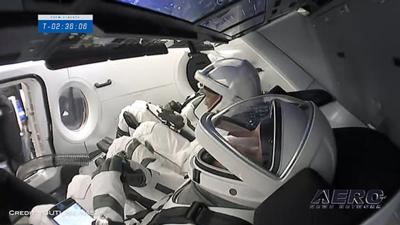A Fourth Crew Member Will Be Added At A Later Date
NASA and the European Space Agency have selected three astronauts to serve as crew members for NASA’s SpaceX Crew-3 mission to the International Space Station, which is expected to launch in the fall of 2021.

The trio will consist of NASA astronauts Raja Chari and Tom Marshburn, who will serve as commander and pilot, respectively, and ESA astronaut Matthias Maurer, who will serve as a mission specialist. A fourth crew member will be added at a later date, following a review by NASA and its international partners.
This will be the first spaceflight for Chari, who became a NASA astronaut in 2017. He was born in Milwaukee, but considers Cedar Falls, Iowa, his hometown. He is a colonel in the U.S. Air Force and joins the mission with extensive experience as a test pilot. He has accumulated more than 2,500 hours of flight time in his career. Chari was selected earlier this month as a member of the Artemis Team and is now eligible for assignment to a future lunar mission.
Marshburn is a Statesville, North Carolina, native who became an astronaut in 2004. Prior to serving in the astronaut corps, the medical doctor served as flight surgeon at NASA’s Johnson Space Center in Houston and later became medical operations lead for the International Space Station. The Crew-3 mission will be his third visit to the space station and his second long-duration mission. Marshburn previously served as a crew member of STS-127 in 2009 and Expedition 34/35, which concluded in 2013.

Maurer comes from Sankt Wendel, in the German state of Saarland. Like Chari, Maurer will be making his first trip to space with the Crew-3 mission. Before becoming an astronaut, Maurer held a number of engineering and research roles, both in a university setting and at ESA. In 2016, Maurer spent 16 days on an undersea mission as part of a NASA’s Extreme Environment Mission Operations, or NEEMO, space analog.
When Chari, Marshburn, and Maurer arrive at the orbiting laboratory, they will become expedition crew members for the duration of their six-month stay. The crew will have a slight overlap with the Crew-2 astronauts, who are expected to launch in the spring of 2021. This will not be the first commercial crew mission to overlap. The Crew-1 astronauts, who are currently on station, and the Crew-2 astronauts, also are expected to coincide in their sojourns for a short time. Increasing the total number of astronauts aboard the station is allowing the agency to boost the number of science investigations conducted in the unique microgravity environment.

This will be the third crew rotation mission of SpaceX’s human space transportation system and its fourth flight with astronauts, including the Demo-2 test flight, to the space station through NASA’s Commercial Crew Program. The goal of the program is to provide safe, reliable, and cost-effective crew access to the space station and low-Earth orbit in partnership with American aerospace industry. NASA’s contract with SpaceX is for six total crew missions to the orbiting laboratory. Commercial transportation to and from the station will provide expanded utility, additional research time, and broader opportunities for discovery on the orbital outpost.
For more than 20 years, humans have lived and worked continuously aboard the International Space Station, advancing scientific knowledge and demonstrating new technologies, making research breakthroughs not possible on Earth. As a global endeavor, 242 people from 19 countries have visited the unique microgravity laboratory that has hosted more than 3,000 research and educational investigations from researchers in 108 countries and areas.
The station is a critical test bed for NASA to understand and overcome the challenges of long-duration spaceflight. As commercial companies focus on providing human transportation services to and from low-Earth orbit, NASA is free to focus on building spacecraft and rockets for deep space missions to the Moon and Mars.
 ANN's Daily Aero-Term (04.25.24): Airport Rotating Beacon
ANN's Daily Aero-Term (04.25.24): Airport Rotating Beacon ANN's Daily Aero-Linx (04.25.24)
ANN's Daily Aero-Linx (04.25.24) Klyde Morris (04.22.24)
Klyde Morris (04.22.24) Airborne 04.24.24: INTEGRAL E, Elixir USA, M700 RVSM
Airborne 04.24.24: INTEGRAL E, Elixir USA, M700 RVSM Airborne 04.22.24: Rotor X Worsens, Airport Fees 4 FNB?, USMC Drone Pilot
Airborne 04.22.24: Rotor X Worsens, Airport Fees 4 FNB?, USMC Drone Pilot





